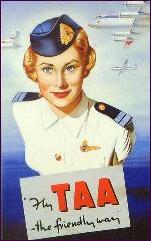
What was happening in Australian civil aviation fifty years ago? This review of a cross-section of events and incidents, particularly within the Department of Civil Aviation (DCA), is gleaned from departmental Annual Reports, Administrative Circulars and from notes prepared by Douglas Gillison (DCA public relations officer) for the international aviation newsletter Interavia.
The year 1949 was not a particularly good one for post-war civil aviation in Australia.
Continuing wartime shortages of materials and manpower, and shortage of dollar reserves in Australia, hampered the purchase of American airline aircraft.
In
June 1949 DCA employed 701 staff in Head Office and 2903 in the newly-created
Regions. The seven regions were:
Victoria/Tasmania (Regional Director J.H.
Harper)
New South Wales (A.H. Cobby)
Queensland (A.W. Doubleday)
Western Australia (D. Ross)
South Australia
(R. Kingsland)
Northern Territory (F. Anderson) and
Papua-New Guinea
(J. Arthur)
There was some difficulty in recruiting staff, as more attractive employment was offered in outside industry. To cope with the increased need for technical staff, DCA introduced a training plan to provide five-year radio and electrical training courses for youths between 15 and 17 years. About 40 were selected for the first intake.
The Department also established two training schools for Communications Officers at Brisbane and Melbourne. The ten-week course included typing skills to a speed of 25 words-per-minute.
Statistics
published in England showed Australians as the most air-minded people in the world.
There were 92 passenger miles flown for every man, woman and child in Australia
compared to the USA (60) , and the Netherlands in third place at 50 passenger
miles.
Our fares were also the lowest. The Melbourne-Sydney fare was less
that three pence per mile, compared to 9.3 pence (Sterling) for the London-Paris
fare.
In May, Civil Aviation Minister Drakeford announced that a 546,000 ($15.3m today) contract for the construction of 95 DME beacons had been let to Amalgamated Wireless (Australasia) Limited.
Of the developments in the air traffic control organisation, perhaps the most appreciated by ATC staff was the gradual replacement of the interference-prone HF (high frequency) communications with VHF air-ground communications. Other new innovations were the Flight Progress Board at major ATC Centres, and the commissioning of the first Runway Localiser beacon at Essendon Airport. It reduced the landing interval between instrument approaches to four minutes, and also reduced the landing minima, with a consequent decrease in diversions to other airports.
Major airports works continued on the construction of an international airport at Mascot. Cooks River was diverted to flow into Botany Bay west of the new airport, and the old river bed filled to form the base of the first of the new runways. At the same time the sewer lines and main highway (General Holmes Drive) were diverted.
Moorabbin and Bankstown were developed as secondary airports for non-radio equipped aircraft. Major airline companies transferred from Archerfield to Eagle Farm, and the new Adelaide/West Beach airport was taking shape.
Mascot was now handling more airline traffic than any other airport in Australia. For the three months to the end of September, Mascot handled 5,356 scheduled aircraft movements while Essendon recorded 4,502, Eagle Farm 3,156 and Parafield 3,525. (Until this time, Essendon had been the busiest airport).
The famous Mobile Maintenance Units in Western Australia and Queensland prepared and maintained landing strips, licenced aerodromes and authorised landing areas. In Queensland, the landing strips at Canobie, Wondoola, Milgarra, Miranda Downs and Delta Downs were extended and widened to ICAO standards.

An arrangement between the Australia and New Zealand governments permitted the
Australian Representative on the Council of ICAO, Dr K.N.E. Bradfield, to represent
both countries.
On 10 March, a Lockheed Lodestar (VH-BAG) operated by Queensland Airlines P/L, crashed after takeoff from Coolangatta aerodrome. All 21 crew and passengers were killed.
A MacRobertson-Miller DC-3 (VH-MME) on a regular public transport service from Perth to Carnarvon took off from Guildford (Perth) in conditions of darkness and moderate rain, climbed steeply until the port wing and nose dropped sharply, after which it dived steeply to the ground. All 18 occupants were killed.
W. Arthur Baird (1891-1954), one of three men who composed the entire initial staff of Q.A.N.T.A.S. Ltd retired from the company on 30 June. He served with the Australian Flying Corps during World War I, and afterwards opened an engineering business in Melbourne. He joined P.J. McGinnis and Hudson Fysh when they flew the first two planes (BE-2a and Avro 504) to Longreach. Under Baird’s direction, DH-50 aircraft were constructed in 1926. He played an important part in developing the Flying Doctor Services and for many years piloted aircraft between Brisbane and Camooweal.
Back
to the main General Organisational
History index
Back to the main Items of General Interest index
If
this page appears without a menu bar at top and left, click
here